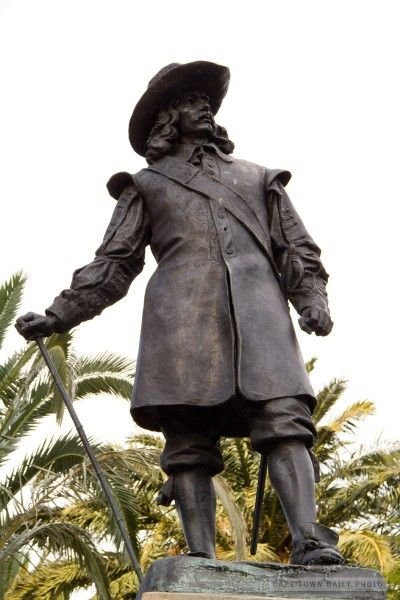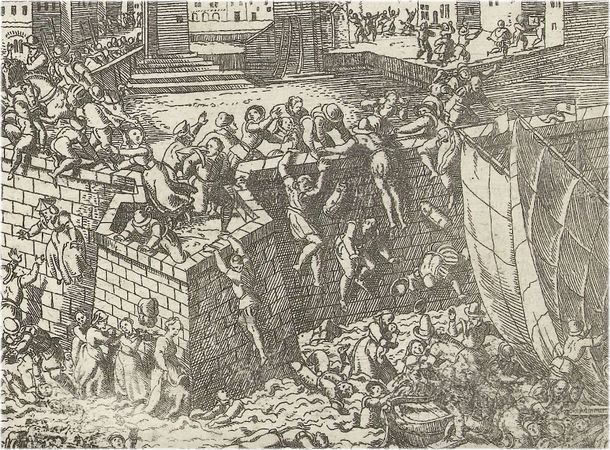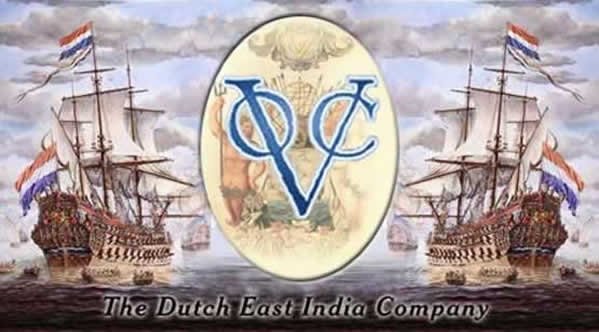AFRIKAANS HISTORY - PART II
So why did Jan van Riebeeck come to the Cape?

STATUE OF JAN VAN RIEBEECK
In the 15th century, the Portuguese held military power over the Indian Ocean as well as the adjoining coasts. They also had a monopoly over trade between Europe and the East. However, they were not responsible for establishing a trading post at the Cape.
This was done by a new trading nation that was on the rise during the 16th century, and became the largest trading nation of Europe in the 17th century: the Netherlands. A contributing factor to their success was the Eighty Years' War (1568 – 1648), also called the Dutch War of Independence, against the mighty Spain and its king, Philip II of Spain. In 1585 Antwerpen fell into the hands of Spain, which was disastrous for the southern provinces. However, for the north it proved to be advantageous, as thousands of knowledgeable and experienced people moved there. As a result, Amsterdam replaced Antwerpen as the most important trading city.

THE FALL OF ANTWERPEN
Trade flourished, based on a policy of freedom. The state did not hamper the entrepreneurship of individuals. Towards the end of the 16th century, prominent Dutch people realised that they themselves would have to sail to East India, with its abundance of expensive spices and other valuable articles. The first expedition between the Netherlands and Indonesia and back, took two and a half years.
Various Dutch companies came into existence, wanting to trade with the East. They ruthlessly competed against each other, and as a result profits dwindled significantly. The amalgamation of the various companies into one united company, in order to gain a trading monopoly, would have been a good solution. However, as a monopoly was against the spirit of free trade, the idea was initially met with opposition. In the end, it was a Dutch state official, Johan van Oldenbarnevelt, who persuaded them to the amalgamation.

VEREENIGDE OOST-INDISCHE COMPAGNIE
As a result, the Vereenigde Oost-Indische Compagnie, the VOC, (Dutch East India Company) was established on 20 March 1602. This powerful company was the first in history to issue shares. The central board, the Here XVII (Lords Seventeen) possessed the highest power, whilst the boards at the various trading posts, also had some limited power, and carried out the decisions of the Here XVII. The VOC concentrated on the Far East, virtually cast out the Portuguese, and kept their main competition, the London Company, at bay. In 1629 the headquarters in the East was established at Batavia (Djakarta), on the island Java. Other settlements were established on the Spice Islands in Ceylon (Sri Lanka), Formosa and Japan.
From the very start, the VOC felt that there was a need for a place where ships could obtain fresh water and food on their long journey between the Netherlands and the East. Without fresh water and food, the seamen could easily contract the life threatening illness, scurvy. In 1647, one of the ships of a return fleet, the Nieuw Haarlem, was shipwrecked at Table Bay and sixty seamen had to spend a year in Table Bay. After their return, the men from the Nieuw Haarlem spoke with enthusiasm of the land in the south: the native Hottentots (Khoi), were genial and willing to trade livestock; crops grew abundantly; and there was plenty of fresh water. One of the shipwrecked men, Leendert Janszen, along with N Proot, recommended in a report that some Dutch people should go and live at the Cape. In 1651 the VOC resolved that this should be done. It is remarkable that one of the considerations for the planned refreshment post was that of language politics. According to Janszen, it would be beneficial for the inhabitants to learn the "Nederlantse spraecke" (Dutch language). Interestingly enough, words from the Dutch, English and other European languages were already in use by the people at the Cape.

VOC SHIPS
In this article I made extensive use of the most wonderful book about the history of the Afrikaner:
Steyn, JC. Afrikanerjoernaal – 'n Vervolgverhaal in 365 episodes. FAK, 2016.
